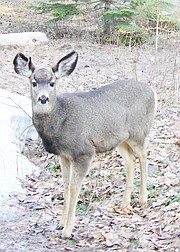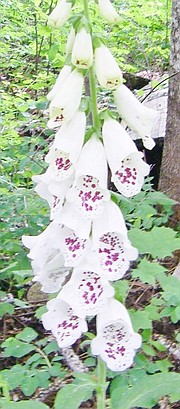Proper planning can deter mooching deer
It seems that though our healthy deer population has mostly moved up the mountains for the summer, a few small groups still seem to hang around and wreak havoc in a host of ornamental gardens.
My garden was on their list for some years, until I finally admitted defeat and took out the plants that they were feeding on — namely Hostas and Huechera (Coral bells) — which had been the focal points of the garden. I thought I would miss them but the changes have been all for the better, and even with last year’s travesty of destruction proved their worth by coming back as lovely as ever.
The years of research, trial and error in my landscape has resulted in solid information that I have shared over time.
First, a little basic information from a much older column: Our area’s deer population consists mainly of the whitetail, Odocoileus virginianus), the mule deer (O. hemionus), and the largest family member, the moose (Alces alces).
The deer, however, had become true garden ravagers which taught me some valuable lessons, for while they destroyed my tulip population, the Hostas (which I expected) and Bergenia (which I didn’t), some Smoke tree (Cotinus) leaves and Hawthorn tree bark (but not the thorny branches), they never touched the daffodils and Poet’s Narcissus.
I began compiling a list and discovered there are many plants they have NEVER touched during my now 40-year residency: To wit: Clematis; Brunnera; Astilbe; Columbine (Aquilegia); Vinca minor (Periwinkle ground cover); Sweet Woodruff ( Galium odoratum or bedstraw); Iris; Peony; Raspberries; Sage (culinary); Lavender; Mint; Mt. Ash; Rocky Mt. Maple; Virginia Creeper; Valerian; Monkshood (Aconitum); Foxglove (Digitalis); Lily-of-the-Valley (Convularia); Ferns; Campanula (Bluebell family); Asters and Chrysanthemums; Lilies; Siberian Pea tree.
A closer look at the above list gives a clue as to the “big four” deer deterrents: odor; toxicity, texture, and prickly parts.
Taken one at a time, we see that first, odor can mean a lot of things, for where deer are concerned, apparently odor and taste are combined. Thus, the marigold and nasturtium petals that we enjoy as edible salad flora are not at all appreciated by Bambi and family.
Too, mints, sage, lavender, petunias, and generally, Roses, are not on the “like” list, along with other aromatic foliage/flowers.
Sometimes it appears, as in the case of roses that the “prickly” part assists with the shunning of the plant.
Deer seem to inherently know what plants are toxic to them, and so never bother the Monkshood, Foxglove, and luckily, the coveted veggie garden members of the Nightshade family: Tomatoes, potatoes, eggplant, and such.
Too, the Narcissus family is toxic to them (as well as to squirrels).
Texture generally means “fuzzy” but can also include rough/tough. This includes a plethora of choice and pretty plants that we can enjoy with no fear of them being consumed. They include Stachys (Lamb’s ears), Rose Campion and Maltese Cross (both Lychnis) — which are more velvety than fuzzy, but equally disliked by the deer as are Mullein and Borage. They also bypass Rudbekia (Black-eyed Susan) and Echinacea (Coneflower). The texture of some succulents also deters deer — Hen and Chicks, Portulaca (Moss rose), Rock Cress, and other such low-growers are generally free from harm. Too, the crunchy leaves of Azaleas and Rhododendrons seem not to appeal to them.
Prickly Parts — thorns, spines and needles, are found on Oregon grape (Mahonia), Holly, Barberry, Flowering Quince, Blackberries/Raspberries/Dewberries, Hawthorn, Spruce, Pine, Juniper, and many Roses (though often, careful browsing on the deer’s part will eke out the buds and blossoms of many non-fragrant species).
It would seem, in going over this list that it would be a simple matter to plan and plant a landscape/garden that the deer will ignore.
Often, native plants serve well in deterring them too, but not always! Because, as bitter experience has shown, when all is said and done, a deer will come by in the night and eat up every single one of those “deer-proof” ornamentals we’ve just talked about!
By the way, garden changes aside, I still plan to have apples and carrots (and alfalfa if I can afford it) to toss out to those deer during a hard, cold, snowy winter. I don’t hate them, and after all, they figure gardens are “browse.”
Last word: Get a copy of the “High Country Gardens” catalog, which has a great list of deer-deterring plants, many of which I probably am unaware of — keep today’s list at hand as well, and then plan your choices and changes.





